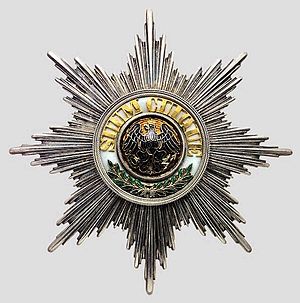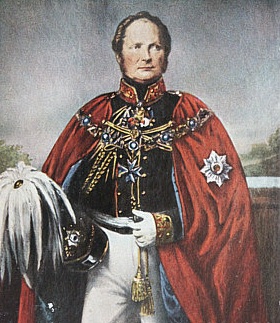Loading AI tools
Highest order of chivalry in the Kingdom of Prussia From Wikipedia, the free encyclopedia
The Order of the Black Eagle (German: Hoher Orden vom Schwarzen Adler) was the highest order of chivalry in the Kingdom of Prussia. The order was founded on 17 January 1701 by Elector Friedrich III of Brandenburg (who became Friedrich I, King in Prussia, the following day). In his Dutch exile after World War I, deposed Emperor Wilhelm II continued to award the order to his family. He made his second wife, Princess Hermine Reuss of Greiz, a Lady in the Order of the Black Eagle.
| Order of the Black Eagle Schwarzer Adlerorden | |
|---|---|
 Star of the Order of the Black Eagle | |
| Type | State Order (formerly) House Order (currently) |
| Established | 17 January 1701 |
| Country | |
| Royal house | House of Hohenzollern |
| Motto | Suum Cuique (idiomatically, "to each according to his merits") |
| Eligibility | Members of ruling houses, senior civil and military officials and other worthy figures appointed by the King of Prussia. |
| Awarded for | Civil or military merit |
| Sovereign | Prince Georg Friedrich |
| Grades | Knight |
| Statistics | |
| First induction | 1701 |
| Total inductees | 407 (to 1918)[1] |
| Precedence | |
| Next (higher) | None |
| Next (lower) | Order of Merit of the Prussian Crown |
Ribbon of the order | |
The statutes of the order were published on 18 January 1701, and revised in 1847. Membership in the Order of the Black Eagle was limited to a small number of knights, and was divided into two classes: members of reigning houses (further divided into members of the House of Hohenzollern and members of other houses, both German and foreign) and capitular knights. Before 1847, membership was limited to nobles, but after that date, capitular knights who were not nobles were raised to the nobility (Adelsstand).[2] Capitular knights were generally high-ranking government officials or military officers.
The Order of the Black Eagle had only one class, but could also be awarded at the king's prerogative "with the Chain" ("mit der Kette") or without ("ohne Kette"). By statute, members of the order also held the Grand Cross of the Order of the Red Eagle, and wore the badge of that order from a ribbon around the neck. From 1862, members of the Prussian royal house, upon award of the Order of the Black Eagle, also received the Prussian Crown Order 1st Class.[3]

The badge of the Order was a gold Maltese cross, enameled in blue, with gold-crowned black eagles between the arms of the cross. The gold center medallion bore the royal monogram of Friedrich I ("FR", for Fredericus Rex).
This badge was worn from either a broad ribbon (or sash) or a collar (or "chain"). The ribbon of the Order was an orange moiré sash worn from the left shoulder to the right hip, with the badge resting on the hip. The sash color was chosen in honor of Louise Henriette of Nassau, daughter of the Prince of Orange and first wife of the great elector. The collar or chain (Kette) was worn around the neck and resting upon the shoulders, with the badge suspended from the front center; the collar had 24 elaborate interlocking links: alternately a black eagle and a device featuring a center medallion with the motto of the Order (Suum Cuique—literally "To each his own," but idiomatically "To each according to his merits"), a series of FRs forming a cross pattern, a blue enameled ring around this, and crowns at each cross point.
The star of the Order was a silver eight-pointed star, with straight or faceted rays depending on the jeweler's design. The center medallion displayed a black eagle (which gripped a wreath of laurels in its left claws and a scepter in its right) on a golden background, surrounded by a white enamelled ring bearing a wreath of laurels and the motto of the Order.
At meetings of the chapter of the Order of the Black Eagle and at certain ceremonies, the knights wore red velvet capes with blue linings. Embroidered on the left shoulder of each cape was a large star of the Order.[3]
From its founding in 1701 to 1918, the Order of the Black Eagle was awarded 407 times, with 57 of these installations occurring during the reign of Friedrich I (1701–1713).[1][4] In 1918, the knights of the order totalled 118 — 14 were members of the Prussian royal house, one was a member of the Princely House of Hohenzollern, 49 (of whom nine were from states then at war with Germany) were members of other reigning houses, and 54 (including 17 who had not yet been fully installed) were nonroyal Germans.[5] Subjects of the Prussian King receiving the order, which was only given in one class, were promoted to the peerage and received a hereditary title.
From the Prussian State Handbooks, it is clear that the Order of the Black Eagle (as well as, by statute, the other Prussian orders, as mentioned above) was conferred upon all male members of the royal family on their 10th birthdays; these men received the collar of the Order on their 18th birthdays. The Order was also conferred upon Prussian queens (and, later, German empresses), though other female members of the royal family usually received the Order of Louise instead.






The Order of the Black Eagle is currently used as the emblem of the German Military Police (Feldjäger).
Seamless Wikipedia browsing. On steroids.
Every time you click a link to Wikipedia, Wiktionary or Wikiquote in your browser's search results, it will show the modern Wikiwand interface.
Wikiwand extension is a five stars, simple, with minimum permission required to keep your browsing private, safe and transparent.